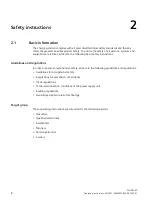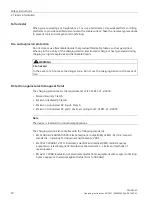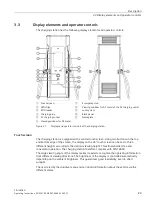
Safety instructions
2.1 Basic information
SICHARGE D
Operating Instructions, 02/2021, 8EM5907-0AA00-1AA7.01
9
Intended use
The SICHARGE D charging station has up to three ports for charging the batteries of electric
vehicles. For this purpose, the vehicle requires a DC charging socket
•
CCS 2
•
CHAdeMO
or an AC charging socket
•
Type 2
The use of adapters between charging plug and vehicle, e.g. for charging vehicles in a way
that deviates from the intended standards, is not permitted.
The charging station can be used indoors and outdoors. The permissible ambient conditions
at the place of use must be observed for intended use. The SICHARGE D charging station may
only be operated in a perfect technical condition. No modifications must be made to the
charging station. This applies to both electrical modifications (connecting, disconnecting or
swapping connections of electrical devices, etc.) and mechanical modifications (e.g. bores).
Modifications void the operating permit and warranty.
In general, any person may use the SICHARGE D charging station to charge electric vehicles in
accordance with the operating requirements. Only trained and authorized personnel is
allowed to perform maintenance. The SICHARGE D charging station may only be opened by
authorized persons (electricians).
The SICHARGE D charging station is intended for charging electric vehicles according to
EN 61851-1/EN 61851-23 and must not be used for other vehicles or purposes. Any other use
or use that goes beyond the use described here is not intended and represents a misuse of
the device.
The charging station must be set up in accordance with the statements in these operating
instructions. Transport, installation, maintenance, cleaning, and normal operation must
follow the instructions or procedures specified in these operating instructions.
Qualified personnel
All work on the charging station may only be performed after having received the proper
instructions. Non-electrical work, e.g. transport and assembly, may only be performed by
qualified personnel. Qualified personnel are qualified by training and experience to recognize
risks arising during the respective work and to avoid possible hazards.
Electrical engineering work may only be performed by qualified electricians themselves or
under their direction and supervision. A qualified electrician is someone who is able to assess
the work assigned to them and recognize potential dangers due to their professional training,
knowledge and experience as well as knowledge of the relevant standards.
Personal protective equipment (PPE)
Personal protective equipment protects you against hazards to your health and safety. Use
your personal protective equipment in accordance with occupational safety guidelines and
accident prevention regulations.











































